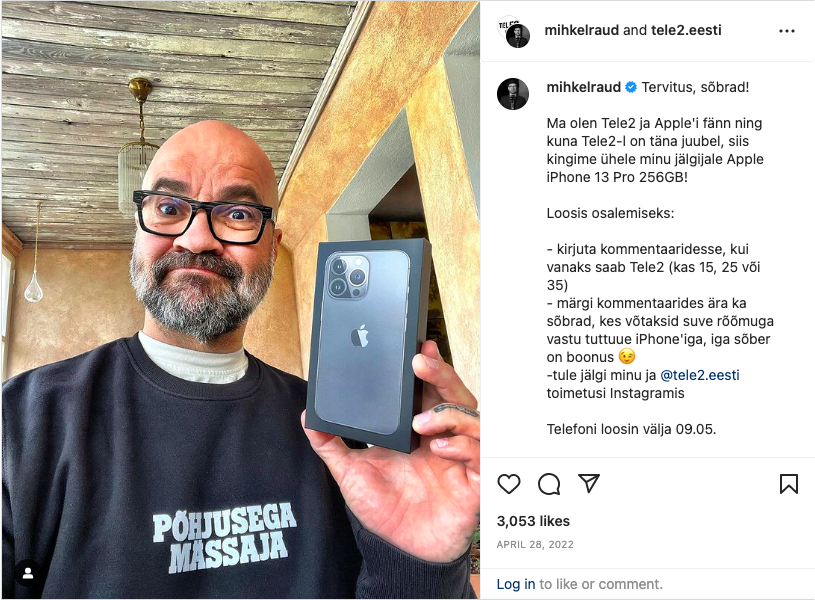How to have a meaningful debate on climate change?
The recent annual conference on natural resources, “Truth or dare”, organised by Äripäev, focused on an important question: how can we turn green transition into a meaningful debate about adapting to climate change? The conference took place to discuss the significant shift in the public discussion on green policy issues in Estonia over the past two years. While the daily news is full of proposals and concrete steps to reduce our environmental footprint, research shows that public awareness and support for the green agenda have not improved.
According to the latest survey commissioned by the Estonian Government Office this spring, only 45% of respondents understand the economic and social changes linked to the green transition. The situation is the same, or even slightly worse, than two years ago: in 2022, 47% of respondents said they understood the changes associated with the green transition.
However, a much more significant change in support for the green transition has fallen from 57% to 48%. In North-Eastern Estonia, support was only 36%. Although there is undoubtedly more than one reason for this, the stagnation of knowledge about the green transition partly explains the drop in support.
It is inevitable that without a clear explanation of green policies and the steps needed to achieve a green transition, there is a risk of doubts about the need for the measures and, conversely, dissatisfaction with the progress made by those who support a faster green transition. This, in turn, encourages the spread of misinformation in various networks and communities, discouraging real action on climate change.
This has happened, for example, in part because of the adoption of renewable energy projects. While wind farms, both onshore and offshore, offer long-term benefits, there are concerns about the costs and environmental impacts of these projects in their start-up phase. There are concerns about visual pollution and noise impacts. However, studies show that wind farms are one of the most cost-effective and cleanest energy sources in the long term.
Therefore, effective measures to combat climate change require close cooperation with residents, municipalities, and businesses. However, top-down guidelines and rules cannot achieve the necessary involvement and support. The focus needs to be on early problem identification and strong community-based cooperation.
“Top-down guidelines and rules cannot achieve the necessary involvement and support.”
Therefore, the state’s role can’t only be to provide legal or resource-based infrastructure, but also co-managing expectations and change. This means that there must be actual contact on the ground, able to identify the genuine concerns of the people causing the resistance or the mitigation measures most relevant in that particular community. Offering financial compensation alone is a solution of convenience – it is more effective for the private and public sectors to work together to focus on the overlapping areas that will genuinely enrich and facilitate local life.
Open local and bilateral communication needs to be accompanied by transparent communication about the whole process. Despite this additional time, policymakers must, in principle, consider the effort required to be fully open about the impacts of climate change action.
It is also essential to discuss the potential risks. Focusing only on the positive aspects of implementing change can lead to disappointment if the reality does not meet expectations. In rapid change, the risk of confusion and dissatisfaction is always high, so adequately managing expectations is essential in any transformation. Communicating honestly and openly will help reduce confusion and disappointment and ultimately support implementing measures to facilitate a green transition.
“Communicating honestly and openly will help reduce confusion and disappointment.”
So, if the question is how can we turn green transition into a meaningful debate, the focus should be on three pillars. Firstly, we can improve people’s understanding of the proposed changes by providing knowledge. Secondly, establishing close cooperation between the state, local authorities and citizens is a must. Finally, we need to explain the processes in a radically open way to avoid any confusion or misunderstanding.
Back in 2013, while I was still a student, I went all out and sent over a hundred CVs in hopes of snagging my first professional gig in marketing. Sadly, most of those applications seemed to vanish into thin air. And when I did manage to get a response, it was usually along the lines of: “Thanks for applying, but we’re seeking candidates with field experience.”
Now, having been on the other side of the hiring table and having brought on board several bright young minds, I’ve got some solid advice for those of you aiming to land your inaugural job.
1. Show your willingness to step out of your comfort zone
Let’s face it: the CVs of young students often look strikingly similar: same alma maters, same majors, same internships. To catch the eye of a recruiter, you need to stand out. Whether it’s an Erasmus exchange time, participation in a specialized program like BAFF, or earning a degree from a foreign university, these experiences can set you apart.
Why do I value these experiences as an employer? They demonstrate your willingness to take risks, push boundaries, and adapt to new environments. In a world where change is constant, adaptability is a prized trait.
Granted, not everyone can jet off to study abroad. In such cases, involvement in youth organizations or projects like Solaride can be excellent alternatives.
2. Leverage opportunities to build your personal brand
In today’s digital era, where anyone can carve out their space online and showcase their talents, having a personal brand is crucial for job seekers. Do you have a lively LinkedIn profile? Do you enjoy creating content on platforms like Instagram or TikTok? These channels allow young professionals to showcase their storytelling skills and visual creativity, giving them an edge in the job market.
3. Pay Attention to detail in your applications
Typos in your cover letter, submitting an English CV for a job in Estonia, or a poorly written introduction— these seemingly minor errors can be the kiss of death when dozens of applicants are vying for the same position. Especially in fields like communications, where clear and concise expression is paramount, attention to detail is key.
4. Research your potential employer
What projects has the company undertaken in the past? What are their standout achievements? How is the communications landscape evolving? Staying informed about the industry and the organization you’re applying to demonstrates your genuine interest and preparedness for the role.
5. Hobbies make you attractive
Work is important, no doubt. But beyond a decent paycheck and a fulfilling career, what most people seek in a job are great colleagues. Employers appreciate individuals with diverse interests and hobbies, as they often bring fresh perspectives and enrich workplace dynamics.
Sure, previous experience is desirable. It can make the onboarding process smoother. However, individuals without extensive professional backgrounds often bring boundless energy and a strong willingness to learn, making them valuable assets in the long run.
Our META IQ internship program is now open for applications starting in March. We offer paid traineeships because we value the time and efforts of our young participants. Moreover, the best trainees are assured of job opportunities within our organization.
Where to start with a communication strategy?
Developing a communication strategy is critical for any organisation that wants to communicate its messages and achieve its communication objectives effectively. While there is often pressure to include all the different aspects of what the organisation is doing, it is essential to focus on the opposite – keeping the strategy as clear and specific as possible. This is the only way to ensure a communication strategy is functional and practical across the organisation.
In general, the purpose of a communication strategy is to define the change that communication needs to drive in an organisation. Formulating a strategy directs all communication activities, thereby helping to avoid wasting resources on irrelevant issues and focus on genuinely practical steps to achieve the organisation’s objectives.
Here are five short suggestions on how to start creating a communication strategy:
1. Clearly define the purpose of the strategy.
Before writing a strategy, it is important to think about what the primary purpose should be. This means understanding what changes the communication needs to bring about in the organisation, whether it is raising awareness, changing attitudes or galvanising action. Having a clear purpose helps to keep the whole process of creating a strategy focused, and the resulting strategy can be used to inform action across the organisation.
2. Analyse the current situation and the change needed.
Conduct a thorough analysis of your organisation’s current communication situation and identify the areas that need to change or improve as a priority. This includes internal and external communications, the effectiveness of existing messages and understanding of target audiences.
3. Map target groups and stakeholders.
Specify who your main target groups and stakeholders are that you want to reach with your communication strategy. Consider which groups are most important to achieve the strategy’s objectives and how to tailor your communication to their needs.
4. Articulate the key messages and tailor them to the needs of target audiences and stakeholders.
Once you have mapped your target and stakeholder groups, clearly articulate the key messages that reflect the objectives of your strategy. Then, tailor these messages to the specific characteristics and preferences of each target group and stakeholder. This will ensure that your messages resonate effectively with different groups, increasing the impact of your communication.
5. Choose the most appropriate channels and methods.
Choose the most effective channels and methods to disseminate your messages based on your objectives and an analysis of your target audience. This could mean using traditional media channels, developing a social media strategy or even direct marketing, depending on what works best for your target audiences.
The worst strategies are the ones that people spend a lot of time and resources on but will never be used. Therefore, avoid being vague and piling up unnecessary policies you don’t have the resources to implement. In the communication strategy, focus only on what is essential for achieving the organisation’s objectives for the next period or where communication plays a key role.
Political January: crisis, conflicts and adjustment
The year 2024 began with a whirlwind of events on the Estonian political landscape that offered surprises and challenges. What does this mean for our businesses and clients, and what can we expect in the coming weeks? Kairi Uustulnd, META partner and head of the government relations team, gives a brief overview.
2024 started intriguingly for policy-makers:
- With the resignation of the Centre Party’s Parliament faction members, the coalition gained four more votes.
- Isamaa enjoys a position in the party rankings that has been rare in recent years – since November, Isamaa has been at the top of the rankings. Behind Isamaa is a close race between the Estonian Conservative People’s Party (EKRE) and the Reform Party. The Social Democrats’ rating is on the rise and holds fourth place, while the Centre Party’s rating is declining and has dropped to fifth. The Estonian 200 has been in sixth place since June 2023.
- The teachers’ strike is one of the most significant social initiatives in recent years, affecting the daily lives of thousands of families. Children are at home, and parents face the challenge of reconciling work and private life. However, the teachers’ strike has brought significant tensions into the Estonian government, with the Reform Party on one side and the Estonian 200 and Social Democrats on the other, in a confrontation over possible solutions.
What does this mean for our businesses and our customers?
- There needs to be some change in government, and in government policy in particular, in the coming months, first to reassure the politicians in the coalition parties themselves.
- When making changes, we need to consider the competitiveness of Estonian companies compared to other countries – Estonia should not apply stricter rules to Estonian companies than those agreed at the EU level.
In the coming weeks, the coalition will face intense and substantive discussions:
- Although Finance Minister Mart Võrklaev has said that businesses no longer have the stamina for tax rises, it is unclear to anyone what kind of tax rises he is talking about. Will it be only the tax increases that we know nothing about, or also those written as ideas on the revenue side of the national budget strategy but have not yet been enacted? No politician or official can answer this question today.
- The finance minister has said that the as-yet-unspecified future tax receipts of €400 million a year, set out without description in the national budget strategy, will likely come from savings. However, all ministers know this is impossible without decisions to cut public services or cancel infrastructure investment.
- The Social Democrats are unhappy that the Reform Party is walking away from tax rises and will push the limits of their influence in the face of a growing parliamentary group.
- Part of the coalition’s perception is that somebody needs to think about future economic growth – and this is the biggest gripe of the business, which has lacked any intelligent forward-looking approach and has scheduled dates to discuss the issue. One year on from the coalition agreement, the government is still expected to have a plan on the critical question underpinning economic and industrial policy: where will green electricity come from in sufficient quantities and at affordable prices to support growth (because no industrial customer will be able to buy anything but clean electricity in 5, 10 and 20 years, given its ESG and financing constraints)?
The period ahead will require adjustment and the definition of explicit political and economic directions.
2023 has been a year of reset and adjustment. Some companies had to shut down, while others faced tough layoffs. However, there has also been a ton of opportunity.
The META Alpha team recently interviewed Siim Teller, Tim Vaino and Yrjo Ojasaar, who have experience supporting startups through their ups and downs. They shared their insights on what matters in 2023/2024, what type of media they follow, and what topics matter for them in communication efforts. As a New Year’s present, we have included 10 questions for founders that can help you align your communication efforts.
It Starts with Your Vision
When talking with investors, one thing became clear: what matters is the vision and mission the founders have to be able to sell. Many startups are too technical initially, and looking over their experience and origin story could build trust between their startups and investors.
According to Teller, the company’s narrative is crucial: “The story that a company tells is one the most important thing,” he emphasized. Teller’s insight suggests that startup primarily sell their vision story, particularly those in the pre-seed and seed stages. A charismatic leader and a compelling story can significantly impact positioning and attract attention.
Many startups face the common challenge of not being able to effectively communicate their product to their target audience through a compelling story. Since emotions drive customers and investors, it’s important to identify their pain points and concerns to craft a narrative that resonates with them. This is where seeking the help of an unbiased third party can be beneficial. They can provide a fresh perspective and ask the right questions that help the founders tell their true origin story in a captivating and engaging way.
General Media or Social Media?
During a discussion on scoring in the media, there were varying opinions. While most investors keep up with Sifted, TechCrunch, and TechEU, accessing local news behind paywalls has become more complex. As a result, LinkedIn has become the primary communication channel. However, it was also mentioned that a single news publication can increase the valuation and generate buzz. „Your valuation could be either 3 million or 5 million, and it might depend only on 1 well-timed coverage,“ according to Ojasaar.
It’s important to have a balanced mix of general and social media. While smaller updates can be shared on LinkedIn or Twitter, sharing anything newsworthy with a larger audience is wise.
Educate Your Audience
Investors are not experts in every field; therefore, it is up to the founder or team member to educate them on the market, explain why it is a promising opportunity, and demonstrate why it would benefit them to invest in it. Additionally, it is important to highlight the team’s unique expertise to differentiate from your competitors.
Some of the participants highlighted a startup called Woola as an excellent example. They educate their customers about the growing use of fossil fuels and the market while explaining in simple terms how their product works and introducing the people behind it.
Navigating the Crowded Marketplace
The startup industry is fiercely competitive, and according to investors, your story, team, revenue, and burn rate are the key factors determining your ability to secure investments.
In this environment, how can you stand out and grab investors’ attention when the investment demand is high? The answer is by networking and contacting investors directly to ask for a coffee meeting. Alternatively, you can leverage your warm leads by talking to startups that have already been or are currently in the investors’ portfolios and learning from their experiences. You should also focus on understanding what went wrong and whether there is a potential fit between your company and the investors.
It’s important to not only focus on established investors but also to engage with younger colleagues who are constantly on the lookout for interesting companies. Doing so can increase your chances of success in securing investments for your startup.
10 QUESTIONS FOR FOUNDERS
- What is our company’s narrative, and how well-defined is our vision and mission?
- Are we open to seeking the assistance of unbiased third parties to provide fresh perspectives on our storytelling and communication efforts?
- What media channels are most relevant to our industry, and where are our potential investors most active?
- Should we prioritize traditional media outlets like TechCrunch or focus on social media platforms like LinkedIn for communication?
- How can we balance general and social media to maximize our reach and impact?
- What key topics do investors need to understand about our market and opportunity?
- Are we highlighting our team’s unique expertise to differentiate ourselves from competitors?
- Are we learning from the experiences of startups in the investors’ portfolios to increase our chances of success?
- Are we proactively reaching out to both established and younger investors to diversify our network?
- How are we adapting our communication strategies to align with evolving trends in the startup ecosystem?
CSR 2.0: How to talk about Social responsibility in the ESG era?
The acronym ESG needs no further introduction in business circles. However, there still needs to be more clarity regarding how this three-letter acronym impacts communication and marketing. What does ESG communication entail? How can it be seamlessly integrated into a communication strategy? What effect does a company’s approach to sustainability have on its reputation?
The new EU legislation, the Corporate Sustainability Reporting Directive (CSRD), has recently garnered significant attention. Consequently, in the coming years, many companies will be required to provide, in addition to financial reporting, information on their social impact across three dimensions: environment, social, and governance. In other words, companies must demonstrate their sustainability within the ESG framework.
In Estonia, around a dozen companies are currently obligated to disclose certain environmental and human rights information, with several others doing so voluntarily. The sustainability reporting obligation will apply to approximately 350 companies in Estonia in the coming years. Furthermore, it will indirectly impact their business partners and the business sector as a whole. Swedbank Estonia has developed a valuable tool, the Sustainability HUB, to help companies understand the practical implications of implementing ESG principles. But how will Europe’s green ambition and the changes it brings affect marketing and communications professionals?
As a side note, it’s essential to acknowledge that linguistic nuances further complicate this already complex subject. Terms like sustainability, ESG, CSR, social responsibility, and responsible entrepreneurship are often used loosely in Estonian and may be perceived differently.
ESG versus CSR
Frequently, all the keywords mentioned above are condensed into the term ESG. Consequently, more and more often, people in the communication community ask, “What is ESG communication?”. The ESG framework primarily serves as an internal tool for companies to assess their business performance across environmental, social, and governance dimensions. From a communication perspective, it plays a role in investor relations and fundraising. However, it should not be used interchangeably with sustainability or social responsibility.
While ESG is a specific framework for evaluating a company’s societal impact, responsibility and sustainability encompass a company’s overall commitment to ethical behaviour and contributing to society. ESG is one way a company can demonstrate its corporate responsibility, but there are other approaches. This principle should be kept in mind in PR.
In communications, I prefer to discuss these concepts within the framework of CSR (Corporate Social Responsibility). Admittedly, the rise of ESG has significantly influenced how companies discuss their social responsibility and how society perceives business sustainability – it can be addressed as CSR 2.0. Since both ESG and CSR are acronyms borrowed from English, I would label it “strategic sustainability communication” in Estonian.
Strategic sustainability communication
It’s crucial to recognize that sustainability communication isn’t an end in itself but a component of strategic business management. Utilizing communication tools can benefit a company in marketing communication, reputation management, employer branding, and relations with decision-makers and partners. Numerous studies have demonstrated that sustainable companies appeal more to investors and partners, and strategic communication is vital for highlighting their sustainability efforts in public relations.
Effective sustainability communication is more than campaign slogans or one-time donations to a CEO’s favoured sports field. As a public relations agency, our goal is to assist businesses in translating sustainability communications into success in their core business areas.
How can we deliver Redundancy Notifications with Empathy and Efficiency?
Redundancy is an unpleasant experience for everyone. It is unpleasant for those who are made redundant; for those who have to make the redundancy decision; for those who have to report it; and for those who remain in the company. Redundancy is a crisis and should be managed as such.
With an uncertain future – it is harder to invest in Estonia because of the geographical risk, Estonia’s exports are falling and the economy is shrinking, and the technology sector is fast becoming profitable – every week there is news of a redundancy decision. Redundancies are often carried out in a way that goes harder than planned and strong brands built up over many years take a heavy reputational hit. How can redundancies be communicated in a way that minimises the damage to a company’s reputation and its people?
- Plan your messages and the redundancy process in advance. Take into account that it will all take time, so bring along the necessary partners. If there is no in-house legal, communications or human resources expertise, bring it in temporarily to the crisis team. Considering the damage that may be caused by redundancy (in effect, the restructuring of the business), this is a justified cost. It is an investment in building the future of the company.
- Communicate the redundancy to the whole organisation together first. Get people together. Remember that information must be based on facts. Colleagues will start leaking and openly criticising the employer if they read information about the redundancy that they believe is not true – this is unavoidable. Bear in mind that anything you say can quickly be leaked to the press. It’s important to pass on information about what has been decided, what the processes are going forward and what support the company is offering to those made redundant. Afterwards, the manager’s presentation should also be sent as a memo to people. Be aware that the contents of this may also be quickly leaked to the press.
- In terms of messaging, it is important to communicate that the redundant person is not to blame – that is the difference between redundancy and dismissal. The company is at a turning point in its development, it needs savings and a strong focus to move forward – this is essential – and therefore redundancies must be made.
- The values of the company are not the text on the wall, but the tried and tested principles of these difficult times. In the overwhelming majority of cases, the long-term impact of redundancies on communications and the overall brand will depend on how one-to-one meetings are conducted with the redundant and whether people feel that managers are sorry for making this decision. Human chit-chat and support services do not make the redundant employee happy and certainly no redundant employee feels sympathy for the manager. However, after a few months or a year, when feelings have been resolved, many will realise that the process could have been handled much worse, and the actions of people and the companies they lead at critical moments will be seen in hindsight through a different lens. People and companies are remembered for the way they behaved in difficult moments.
- Redundancies are also difficult moments for those who remain. People may doubt the sustainability of their organisation, start looking for new jobs, feel demotivated, or lose their jobs. It is also important to support them at this stage and to give them messages about what the company is doing to emerge from the crisis. It is important to say that the leaders have a clear plan for how to achieve the new goals and what the role and perhaps the increased opportunities are for the survivors to share in the success, if they are to get through the difficult times together. It’s important not to fudge here – it’s not possible to say that we are making redundancies because we are doing well. It will upset those who have been made redundant as well as those who remain. But this difficult moment is an opportunity to communicate a plan to build a better future and to get people thinking and acting with us.
Meta Advisory launched a start-up business line
META Advisory, Estonia’s leading public relations advisor, has created a new business team, Meta Alpha, focused on supporting the growth of start-up companies. The team is made up of experts in startup communications and marketing.
Over the years, META Advisory has advised Uber, Starship, Lightyear, Walt, Kwota, Äio, Bikeep, Snabb, Jobbatical, MeetFrank, Skeleton, Clevon, Eleport, Futugrid, GScan and many others. “We have already spent a decade supporting the growth of dozens of Estonian tech startups – from building messaging platforms to fundraising and communicating their expansion into foreign markets. The lessons learned are simple: start-ups communicate differently from profitable market leaders. A start-up that wants to grow fast also needs an advisor who can deliver rapid and measurable results, a willingness to experiment, make mistakes and try again from the ground up. But above all, flexibility – both in terms of the forms of collaboration and the changing objectives. Based on this experience, we designed a separate team with a higher risk appetite, with working time and capacity equal to that of our start-up clients, and with the ability to take into account the particularities of the start-up’s developmental stages,” said Ann Hiiemaa, partner of Meta Advisory and head of Meta Alpha.
Just as Meta Advisory was founded at the bottom of the great financial crisis in 2009, the time to build an advisory team with a tailored approach to start-ups is now, when tech finance is struggling and more needs to be done with less. It also means that META Alpha’s service portfolio is much broader than just media relations and local PR. The team includes the market’s strongest growth marketers, SEO specialists and business advisors.
“Our strength lies in our experience – our team members have built start-ups and consulted both leading Estonian start-ups and businesses just starting out. We’ve learned from our own successes and also from difficult decisions. We know what gets results and what just burns money and energy. We focus on where we can expect results and growth,” Hiiemaa concluded.
Prior to the creation of the new business line, Meta Alpha conducted a survey among startup leaders, which clearly showed that the main focus of the companies is raising money and launching new products or services. While more than half of start-up founders do their own marketing and communication, 30% of respondents use an in-house specialist and only 10% use an external agency.
According to Lily Mägi, Head of Client Relations at Meta Alpha, there are not enough strong people and resources with a marketing communications background in the early stages of start-up development. “One person cannot cover all the marketing needs of a company. META Alpha is a marketing communications team that works with the company on everything from positioning to growth marketing. Our job is to create order where a start-up company is still in disarray – we build up the functions that support the growth of the start-up’s core business,” added Mägi, who said the survey showed that it was important for one-third of respondents to reach the world’s leading media outlets that are important to their target groups. This is why Alpha is focusing on expanding its global PR strengths. “Meta Alpha is also part of Convoy, the world’s leading technology communications network. This enables us to quickly find strong partners in all the world’s major capitals and business centres,” said Mägi.
META Alpha is a business line of META Advisory, Estonia’s leading public relations advisor, created to support the development of start-ups in the Baltic region. The team includes Madis Trei, who focuses on growth marketing, SEO specialist Annika Helendi, copywriters Maria Magdalena Lamp and Vira Suarez, and product and service development consultant Anni Sinijärv. In addition, Meta Alpha’s startup portfolio includes international technology communications network Convoy and Rud Pedersen Group companies in Europe and other Meta Advisory partners worldwide.
The Metaverse: A New Frontier for PR and Marketing
The metaverse is a term used to describe a virtual universe, where individuals can interact with each other and digital objects in real time. It’s a simulation of the physical world but in a virtual environment. The metaverse has been a popular concept in science fiction for decades, but with advancements in technology, it is becoming a reality.

The metaverse has various applications in entertainment, education, commerce, and social interaction. In the world of PR and marketing, the metaverse presents a unique opportunity for brands to engage with their audience in a new and innovative way.
Using the Metaverse for PR and Marketing
- Virtual Product Launches: Product launches are a crucial aspect of marketing, and the metaverse provides a new platform to showcase products in a virtual environment. Brands can create immersive experiences that allow customers to interact with products and see how they work. This approach can generate buzz and excitement around a product launch, while also providing customers with an interactive and memorable experience.
- Virtual Event Hosting: The metaverse offers a new way to host events, including trade shows, conferences, and product demonstrations. Brands can create virtual event spaces that can be accessed by attendees from anywhere in the world. This can significantly reduce the cost and carbon footprint associated with physical events, while also providing a more inclusive and accessible experience.
- Interactive Advertising: The metaverse provides an opportunity for brands to create interactive and engaging advertisements. Advertisers can create virtual environments that allow customers to interact with products, learn about services, and experience the brand in a unique way. This approach to advertising can drive engagement and increase brand awareness.
- Influencer Marketing: The metaverse also provides a platform for influencer marketing. Influencers can create virtual environments where they can interact with their followers, showcase products, and provide demonstrations. This can provide brands with a new way to reach audiences and increase their visibility.
- Driving Sales: The metaverse can also be used to drive sales and increase revenue. Virtual stores and shopping experiences can be created, giving customers the ability to try on products and make purchases in a virtual environment. This can be especially useful for companies selling products that are difficult to visualize, such as furniture or home décor.
Overall, The metaverse presents a unique opportunity for brands to engage with their audience in a new and innovative way. By leveraging the power of virtual reality, brands can create interactive experiences that generate buzz, increase brand awareness, and drive engagement.
As the metaverse continues to evolve, it will likely play a significant role in shaping the future of PR and marketing. But the easiest first step you could already make today is creating your avatar with Ready Player Me here – https://readyplayer.me/avatar.
This article is 80% written by ChatGPT.
How to choose the right influencer for your brand?
In 2004, Facebook made its debut and shook the advertising, PR, and marketing industries to their core. What began as a platform to connect people transformed into a popular commercial hub for businesses. Six years later, in 2010, Instagram was introduced and only amplified the game-changing impact of social media on the aforementioned fields.
It’s a well-known fact that referral marketing is one of the most effective forms of advertising. To capitalise on this, an increasing number of brands are tapping into the power of Instagram content creators for their marketing campaigns. These influencers offer a unique and personalised perspective that sets them apart from the typical TV advertising approach. Brands must exercise caution and make a thorough, well-informed decision when choosing a content creator, as their endorsement carries significant weight.
The concept of influencer marketing can be complex, leading to numerous inquiries. To clarify and demystify the subject, I’ve gathered a selection of the most commonly asked questions that I encounter in my daily interactions.
1. Is there compatibility between the content and values of the influencer’s platform and my business?
A company’s brand and image are essential in achieving its business objectives. It’s, therefore, imperative to exercise caution when selecting individuals to represent the brand. Take, for instance, an environmentally conscious company for which sustainability is a top priority. This company would not want to partner with an influencer who, despite having made a few eco-friendly statements, actively promotes fast fashion brands. The ideal influencer partners are those whose values align with the company.
example: boohoo x kourtney kardashian
A recent case in point is the American fast fashion brand Boohoo’s collaboration with Kourtney Kardashian, who was appointed brand ambassador to steer the company towards a more sustainable fashion direction. However, this move was met with widespread criticism. This was in part due to the fact that the wealthy and well-known public figure is not known for leading an environmentally conscious lifestyle, frequently using private jets and exhibiting a high level of consumption. Despite facing ongoing public pressure for its harmful environmental practices, Boohoo could have improved its image with regard to sustainability by choosing a more appropriate influencer. Instead, their selection of the wrong influencer resulted in further harm to their reputation.
Read more about the case here.

2. Why is communication between the brand and influencer important?
The importance of clear communication in influencer marketing partnerships cannot be overstated. A lack of clear expectations and guidelines can lead to misunderstandings and dissatisfaction on both sides. It is imperative that companies provide a comprehensive brief to their influencer partners, outlining the content, parameters, and conditions of the collaboration. This sets the foundation for a productive and successful partnership. Failing to effectively communicate can result in unmet expectations and dissatisfaction with the partnership.
The Key to Successful Collaboration: A Guide for Brands
Collaborating with influencers can be a great way to reach a wider audience and promote a product or brand, but it’s important to have clear communication to ensure success. Here are some guidelines for brands to follow to have a successful collaboration with an influencer:
- Precision is Key: When outlining the collaboration, be as detailed as possible about the content of the post, the level of creative freedom for the influencer, and the conditions they must follow. This helps to manage expectations and prevent misunderstandings down the line.
- Approval Process: Make it clear from the outset that the client must approve the content before it is posted to avoid factual errors and ensure the idea is coherently understood.
- Content and Channels: Agree on the specific content of the post and the social media channels where it will be shared.
- Scope of Collaboration: Clearly define the number of posts and stories the influencer will create, and have a clear understanding of their pricing structure.
- Copyright Matters: If the post uses music and is a paid collaboration, make sure to pay attention to copyright issues.
- Use the Product: When promoting a product, it’s more credible if the influencer actually uses it in the post, rather than just holding it.
- Hashtags and Usernames: Include the exact usernames and hashtags the influencer needs to include in the post.
3. Why is it so expensive to work with influencers?
Collaborating with influencers on Instagram is not unlike buying advertising space from online media outlets. Just as advertisements appear alongside website articles, influencers promote products and services on their social media channels and receive compensation for their efforts. With the time and effort influencers put into creating and publishing posts, it’s reasonable for them to charge for their services. Furthermore, working with influencers provides companies with a sense of security and a written agreement outlining their expectations.
In some cases, influencers may agree to promote products in exchange for the items themselves, but this is typically only feasible when the products are expensive. The cost of working with influencers in Estonia may vary, and companies may find that influencers in Latvia and Lithuania charge less for their services. For companies with a target market spread across the Baltic States, exploring collaborations with Latvian and Lithuanian influencers may be worth considering.
4. When to enter into long-term cooperation?
Long-term partnerships between companies and influencers can contribute to building brand loyalty. Consistent collaborations demonstrate the partnership’s effectiveness and stability, making it more beneficial for both parties than constantly changing influencer partners. For example, if a telecommunications company works with different influencers each month, the brand may lack continuity and stability. On the other hand, if a company invests in a year-long partnership with a single influencer, the influencer will become more familiar with the brand, leading to a more natural and effective partnership.
Investing in long-term collaborations with influencers can also save time and money in the long run. Companies won’t need to repeatedly explain their brand’s values and objectives, and the influencer will gain a deeper understanding of the brand over time.
example: tele2 x mihkel raud
Our client Tele2, a leading telecommunications provider, has demonstrated the power of long-term collaboration in its partnership with influencer Mihkel Raud. Raud has been a prominent figure in Tele2’s “hardware” section of their blog, providing his followers with exciting and informative reviews of the company’s products and services. This dedicated contribution to the brand has not only built anticipation among Raud’s followers but has also solidified his position as a trusted influencer and Tele2 customer. This seamless integration of brand and influencer has resulted in a more authentic and confident impact on the target audience, solidifying the success of the long-term collaboration by repeatedly explain their brand’s values and objectives, and the influencer will gain a deeper understanding of the brand over time.

5. What are the numbers that bring success when working with influencers?
The notion that partnering with an influencer with a large following is a recipe for success is often misleading. In reality, the number of followers is not a reliable indicator of success in influencer marketing. Instead, the engagement rate, or the level of interaction between the influencer and their audience, is a key metric to consider. In Estonia, there are instances where influencers have tens of thousands of followers but exhibit a low engagement rate of 0%.
The rapidly changing algorithms of Instagram make it increasingly difficult to stay abreast of trends in the industry. Buying followers, prevalent on the platform, can contribute to an influencer’s low engagement rate. However, this should not automatically disqualify a potential collaboration, as the influencer may still resonate well with the target audience. It’s essential to take a holistic approach and consider the bigger picture. Companies can also request the influencer’s engagement rate or use influencer marketing platforms to measure their statistics.
example: maria rannaväli x buying followers
In Estonia’s influencer landscape, one example of the pitfalls of relying solely on followers as a success metric is the story of Maria Rannaväli. One of Estonia’s biggest influencers had 64,000 followers, but a malicious individual bought more followers to her account, raising the count to 400,000. The impact of this artificial increase in followers was significant, as the engagement rate plummeted when dividing likes, comments, and views by the new, inflated number of followers. This serves as a cautionary tale for brands, highlighting the importance of looking beyond simple follower counts.
Read more about the case here.

6. How to analyse the effectiveness of cooperation?
Once a collaboration with an influencer has been established, you have to evaluate its results. Measuring the impact of influencer marketing is one of the few concrete ways of determining the effectiveness of a communication strategy. E-commerce and promotional code data provide tangible metrics for success, but every brand has different goals for its influencer marketing campaigns. To fully assess the impact of a partnership, it’s recommended to gather post statistics from the influencer a few weeks after the content has been published. Analyse the engagement, clicks, and performance of links and promotional codes. To gain valuable insights and optimise future campaigns, it’s essential to compare the results over an extended period of time and determine what’s resonating with the target audience.

NB! Microsoft on loobunud Internet Exploreri arendamisest ning sellele uuenduste tegemisest ja ei soovita antud internetibrauserit turvanõrkuste tõttu kasutada. Internet Explorer ei toeta enam uusi võrgustandardeid ning antud veebilahendus ei tööta siinses brauseris korrektselt.
Palun lae alla mõni moodne veebilehitseja:
The website uses cookies. Cookies are required for your convenience and web statistics. By continuing to use the website, you agree to the terms of the privacy of cookies! You can see the terms of the privacy policy in here.








